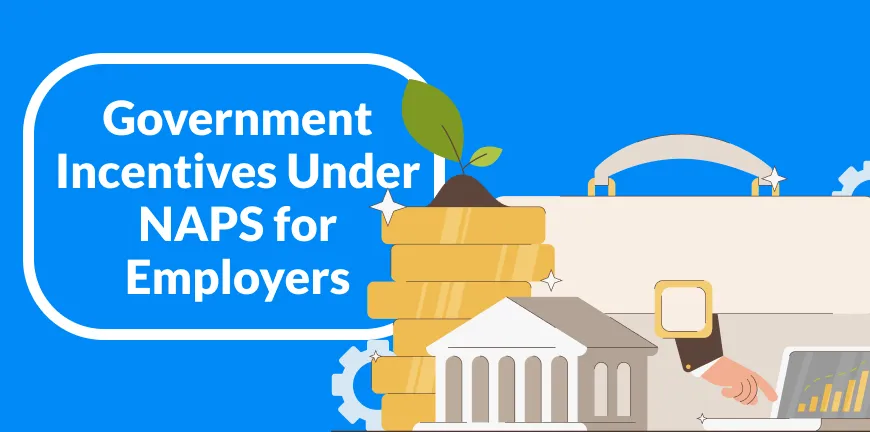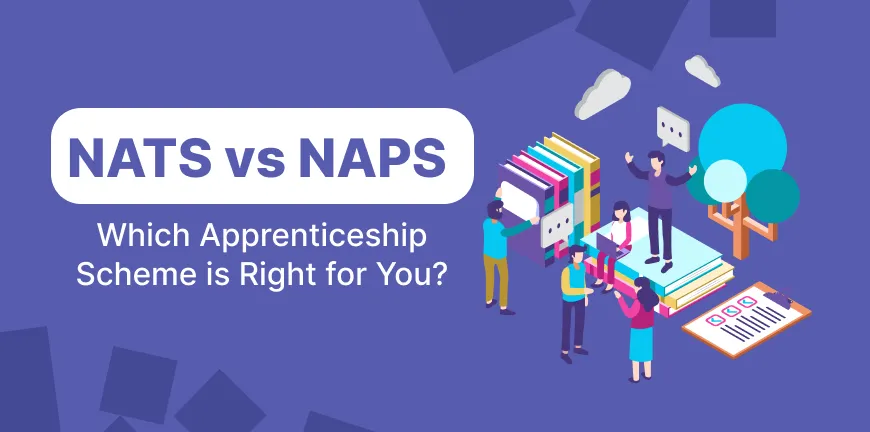
Top Industries Using NAPS for Workforce Development
05/09/2025
What Is Leadership Style? Top Styles Every Manager Should Know in 2025
07/09/2025- What is the NAPS Scheme for Employers?
- How Does NAPS Benefit Employers in India?
- What Are the Financial Incentives Provided Under NAPS?
- How Can Employers Apply for NAPS Incentives?
- Which Industries Can Avail NAPS Benefits?
- What Are the Compliance Requirements for NAPS Employers?
- How Do NAPS Incentives Improve Workforce Skill Development?
- What Are the Recent Updates to NAPS Employer Benefits?
- How Do Employers Track Their NAPS Subsidies and Incentives?
- What Are the Best Practices for Maximizing NAPS Benefits?
- How Do NAPS Incentives Support Long-Term Talent Planning?
- What Are Common Challenges for Employers Under NAPS?
- How Can Businesses Align Their HR Strategy with NAPS Incentives?
- What Metrics Should Employers Monitor for NAPS Success?
- Conclusion: Why Employers Should Leverage NAPS Incentives
- Key Takeaways
- Frequently Asked Questions
Apprenticeships open a floodgate of opportunities, and it is a win-win-win situation for all: industry, candidates, and the country.” – Jayant Krishna, Executive Director & COO, NSDC.
Currently, the NAPS program has gained a lot of traction among employers since it offers a lot of incentives and allows the creation of customised training programs to match organisational needs instead of following a standard curriculum. Currently, nearly 2 lakh establishments have registered under NAPS and are enjoying its benefits.
As of June 2025, employers are actively training 852,376 apprentices, with a significant 23% being women under the NAPS program. However, many companies are still sceptical about NAPS and are refraining from implementing it in their organisation.
In this exclusive NAPS blog, let’s discuss how employers can leverage government incentives under NAPS and reduce their training costs while building a strong talent pipeline across all sectors. Go!
What is the NAPS Scheme for Employers?
Every company looks to tap into young talent and looks for effective talent acquisition strategies that are cost-effective yet provide access to a diverse talent pool. This is where NAPs (National Apprenticeship Promotion Scheme) can act as a catalyst for employers to get top talent on board in a short duration, with reduced HR efforts, and the government covering the bulk of the training expenses. The key features that make the NAPS scheme appealing for employers in India include:
- Employers receive reimbursement of stipend costs, reducing overall training expenses for hiring skilled apprentices effectively.
- Employers have the freedom to design apprenticeship training programs that fulfill business demands & future workforce needs.
- NAPS‘s structured, on-the-job training boosts apprentices’ employability while building sustainable, future-ready workforce pipelines for employers.
- Easy to register apprenticeship portal & continuous support ensure company owners efficiently hire top candidates & fulfil government obligations simultaneously.
- Employers develop skilled talent pools using NAPS, ensuring long-term workforce availability while minimizing recurring recruitment & hiring challenges.
How Does NAPS Benefit Employers in India?
As we will realise right throughout this NAPS blog, the scheme is equally beneficial for both employers and job seekers. As mandated under the Apprentices Act, 1961, Employers with 30 or more employees must engage a minimum of 2.5% to 15% apprentices in their workforce. However, instead of treating it as an obligation, employers can use NAPS to their advantage and create a job-ready workforce at relatively less cost.
Here are 5 key benefits offered NAPS program for employers:
1. Cost-Effective Training
Employers will be able to cut down workforce development expenses via government stipend reimbursements. This ensures affordable and sustainable long-term apprenticeship training programs.
2. Customized Skill Alignment
NAPS offers flexibility for employers to churn out apprenticeship training programs tailored to their vision, ensuring workforce skills meet evolving business requirements.
3. Reliable Talent Pipeline
Employers can amass a steady pipeline of skilled professionals through NAPS. This reduces recruitment challenges & ensures continuity across critical business functions.
4. Enhanced Workforce Productivity
Structured apprenticeship programs under NAPS elevate efficiency, lower attrition rates, & foster loyalty among candidates trained under this scheme.
5. Stronger Employer Branding
Participation in NAPS strengthens employer reputation, highlighting commitment to national skill development and social responsibility initiatives.
What Are the Financial Incentives Provided Under NAPS?
In this NAPS blog, we will be continuously focusing on financial incentives gained by both employers and employees under the scheme. Here is the table that describes the financial incentives provided under NAPS for employers and apprentices currently.
| Category | Financial Incentives Provided Under NAPS |
| Employers | Reimbursement of 25% of the prescribed stipend (up to INR 1,500 per apprentice per month) from the GOI.
Sharing of Basic Training Costs up to INR. 7,500 per apprentice for fresher apprentices requiring basic training. |
| Employees (Apprentices) | Receive a monthly stipend as per prescribed rates under the Apprentices Act, partly reimbursed to employers through NAPS.
· School pass-outs (Class 5th – Class 9th) – INR 5,000 · School pass-outs (class 10th) – INR 6,000 · School pass-outs (class 12th) – INR 7,000 · National or State Certificate holder – INR 7,000 · Technician (vocational) apprentice or Sandwich Course (Students from Diploma Institutions) or Vocational Certificate holder – INR 7,000 · Technician apprentices or Diploma holder in any discipline or Sandwich Course (Students from Graduate Institutions) – INR.8,000 · Graduate apprentices or Degree apprentices or Degree in any discipline – INR.9,000 Access to free basic training programs funded by the government, enhancing employability and industry-specific skills. |
How Can Employers Apply for NAPS Incentives?
Here is the step-by-step NAPS application process for employers to get approval for enrolling apprentices under the NAPS program.
Eligibility criteria for Employers
- Employers must have 30 or more employees working in their organisation.
- Employers can engage apprentices equivalent to 2.5-10% of their total workforce.
- The company must be registered under EPFO, ESIC, MSME (e.g., Udyog Aadhaar), and hold a valid GSTIN, TIN, or TAN.
- The company must be registered under the Apprenticeship India Portal.
Application Process
- Visit the official Apprenticeship India portal.
- Click on the home and click on the tab that says, “Register as an Establishment.”
- Provide accurate company details like name, registered address, industry type, PAN & GST details, and contact information.
- Online verification of submitted company details will be carried out through government databases.
- Upload the required documents like the establishment registration certificate, GST & PAN certificate, business address proof, etc.
- Log in to the dashboard and complete the profile with details about training infrastructure, workforce strength, & the specific apprenticeship requirements.
- Once the profile is submitted and approved by the respective authority, companies can commence posting apprenticeship opportunities, invite candidates, and manage their contracts directly through the platform.
Documents Required
- PAN and TAN details of the organization.
- Proof of address for the establishment.
- GST Registration certificate.
- Employer identity proof (e.g., Aadhaar card).
- Bank account details to receive stipend reimbursement.
- Details about the proposed Training Programme Outline.
- Records of labour law compliance.
- Details on the establishment’s total workforce strength.
Which Industries Can Avail NAPS Benefits?
As we are going through this NAPS blog, we can observe that this scheme has a lot of scope and can benefit employers and candidates with expertise in various industry trades. Here are the top 8 industries that can gain maximum benefits from enrolling in the NAPS program.
1. Manufacturing
The employers can train apprentices in specific production processes, machinery operations, & quality systems under NAPS.
2. Automotive
Companies running automotive operations can build a skilled workforce using the NAPS program for vehicle assembly, repair, servicing, and R&D.
3. Information Technology (IT)
NAPS has now stretched its wings to the IT industry as well. Employers can provide training to apprentices in software development, support, testing, & IT infrastructure.
4. Healthcare
Hospitals can build and groom talent in nursing, diagnostics, lab technology, & hospital management roles.
5. Retail & E-Commerce
Employers can train apprentices registered under NAPS in customer service, logistics, sales, & digital operations.
6. Banking & Finance
Fintech companies can build a job-ready workforce in accounting, compliance, analytics, customer support, and financial services.
7. Hospitality & Tourism
The employers running hospitality and travel industries can provide apprenticeship training in culinary arts, housekeeping, event management, and guest relations.
8. Construction & Infrastructure
The construction companies can develop apprentices in civil works, electrical, plumbing, project management, and safety.
What Are the Compliance Requirements for NAPS Employers?
Here are the key compliance obligations that companies must fulfil to execute the NAPS program smoothly:
- Employers must register their firm on the official apprenticeship India portal & declare the exact apprenticeship seats available within the permissible workforce percentage of 2.5%-15%.
- Signed apprenticeship contracts between employers and apprentices must be uploaded on the portal and approved by the Regional Directorate of Apprenticeship Training authorities.
- Employers must provide prescribed stipend rates to enrolled apprentices regularly. Also, the records must be uploaded digitally to claim government reimbursements under the NAPS scheme.
- Attendance, apprenticeship training progress, & assessment details of apprentices must be accurately logged and updated on the Apprenticeship India portal without fail.
- Employers are mandated to offer on-the-job training aligned with industry standards, ensuring apprentices gain practical and employable skills effectively.
- Compliance with labour laws, safety regulations, & equal opportunity guidelines is mandatory during apprenticeship engagement under the NAPS framework.
- Employers must submit claims for stipend reimbursement & basic training cost support only after disbursing payments directly to apprentices’ bank accounts.
How Do NAPS Incentives Improve Workforce Skill Development?
Here are 5 ways NAPS incentives will boost workforce skill development initiatives:
1. Expanded Training Opportunities
Government-funded stipends under NAPS encourage employers to get apprentices on board frequently, creating wider access to structured skill development.
2. Industry-Aligned Skill Building
NAPS training polishes apprentice capabilities with business needs, ensuring the workforce is immediately productive and job-ready.
3. Investment in Quality Training
Substantial financial support motivates employers to invest in enhancing training infrastructure. This proactive approach boosts apprenticeship program standards and overall effectiveness.
4. Practical Hands-On Exposure
Apprentices enrolled under NAPS gain real-world exposure. This bridges the critical skill gap between academic learning and industry expectations.
5. Sustainable Talent Pipeline
Incentivized apprenticeships foster a continuous learning culture, building a future-ready, skilled workforce for long-term industry growth.
What Are the Recent Updates to NAPS Employer Benefits?
In this NAPS blog, we are also covering the latest updates on the benefits offered to employers under the NAPS initiative. Here are a few of them:
- The Central Apprenticeship Council has proposed a 36% stipend rise, raising apprentice stipends from INR 5,000 – INR 9,000 to INR 6,800– INR 12,300.
- The Central Apprenticeship Council has initiated steps to adjust stipend rates automatically every two years based on Consumer Price Index (CPI) inflation changes.
- Industry coding has been updated, replacing the 1987 list with the NIC-2008 for broader sector inclusion in the NAPS program.
- Degree-apprenticeship programs have been introduced under NAPS, enabling apprentices to earn formal degrees while gaining on-the-job training.
- Digital and blended training are now permitted under NAPS, allowing flexible, online, and virtual apprenticeship delivery beyond physical classrooms.
How Do Employers Track Their NAPS Subsidies and Incentives?
Here are the key steps employers need to follow to track NAPS subsidies and incentives:
1. Portal Login
Employers log in to the official Apprenticeship India portal using registered establishment credentials to access the subsidy tracking dashboard.
2. Dashboard Monitoring
Real-time portal dashboard displays the status of stipend reimbursements, basic training claims, and pending approvals for each engaged apprentice.
3. Claim Submission Verification
Employers upload stipend proof and training records. Then, the portal generates a ‘claim acknowledgment’ for monitoring reimbursement progress and verification status.
4. Approval Status Tracking
Regional Directorate of Apprenticeship Training (RDAT) or State Apprenticeship Adviser updates claim status, visible on the employer’s portal dashboard.
5. Bank Account Updates
Employers track reimbursement credits directly in Aadhaar-linked bank accounts after claims are approved by competent authorities online.
6. Periodic Reports
Monthly and quarterly digital reports on claims, reimbursements, and pending subsidies help employers reconcile financial planning effectively.
What Are the Best Practices for Maximizing NAPS Benefits?
The main aim of this NAPS blog is to guide employers to get maximum benefits out of the program and get access to top talent. Here are 5 best practices to utilize the NAPS program in the best possible way:
1. Strategic Apprentice Planning
Companies serious about building a talent pool through NAPS must align apprenticeship intake with workforce requirements. This diligent approach ensures optimal utilization of government subsidies and long-term skill development outcomes.
2. Structured Training Programs
The management can design industry-relevant training modules that have the right mix of classroom & on-the-job learning. These structured programs enhance apprentice productivity & make them eligible for a permanent hire.
3. Accurate Record Management
The HR team must maintain timely, accurate digital records of contracts, stipends, & training progress on the Apprenticeship India portal for compliance.
4. Leverage Government Support
The firm must utilize available reimbursements for stipends and training costs to the maximum extent. This reduces financial burden while improving workforce development investments.
5. Foster Retention Pathways
The company must offer career progression opportunities post-apprenticeship. This move converts skilled apprentices into loyal employees and ensures long-term workforce sustainability.
How Do NAPS Incentives Support Long-Term Talent Planning?
Here are 5 ways NAPS incentives help companies in long-term talent planning:
1. Sustainable Skill Pipeline
The NAPS program acts as a catalyst to build a diverse pipeline of employable apprentices. This ensures firms fulfil evolving workforce needs with reduced recruitment costs.
2. Reduced Hiring Gaps
Apprentices trained under the NAPS program are much better equipped than freshers & can transition seamlessly into roles. This reduces future hiring delays & workforce shortfall across sectors.
3. Cost-Effective Workforce Planning
Government-supported stipends and training reimbursements through NAPS give strong impetus to employers for strategically investing in developing talent that aligns with future business goals.
4. Enhanced Retention Potential
Apprentices who blend into the company’s culture early often demonstrate stronger loyalty. This way of talent addition to the workforce lowers attrition and stabilizes long-term workforce structures effectively.
5. Industry-Relevant Competencies
Customized apprenticeship training empowers employees & helps them gain practical and job-specific skills. This supports organizations’ long-term competitiveness & operational excellence.
What Are Common Challenges for Employers Under NAPS?
Here are the top 5 challenges faced by employers in implementing NAPS:
1. Administrative Complexity
Managing contracts, digital uploads, and portal compliance requirements can overload HR teams, especially small enterprises or startups with meagre HR resources.
2. Reimbursement Delays
Employers often experience delays in receiving stipend reimbursements, disrupting financial planning and discouraging consistent participation in the scheme.
3. Awareness Gaps
Limited understanding of NAPS policies, eligibility norms, and benefits restricts employers from maximizing program potential effectively across sectors.
4. Training Infrastructure Limitations
Some employers lack adequate training facilities, mentors, or structured programs. This lack of direction reduces apprentices’ learning outcomes and scheme effectiveness.
5. High Attrition Rates
Trained apprentices frequently leave after program completion due to a lack of substantial compensation. This impacts workforce continuity and reduces long-term return on training investments.
How Can Businesses Align Their HR Strategy with NAPS Incentives?
The main objective of this NAPS blog is to help companies align the NAPS program with their business goals rather than just running it as an obligation to meet compliance requirements. Here are 5 ways businesses can align their HR strategies with NAPS incentives:
1. Workforce Planning Integration
Map apprenticeship roles with future workforce needs. This ensures talent pipelines align seamlessly with organizational growth and expansion strategies.
2. Structured Training Frameworks
Design competency-based training that is in line with industry standards. This elevates apprentice performance & supports long-term HR talent development goals.
3. Leveraging TPA Expertise
Partner with authorized TPAs like ALP Consulting for streamlined NAPS onboarding, compliance management, and maximizing government subsidy utilization.
4. Retention-Oriented Policies
Introduce career progression pathways post-apprenticeship. This move will convert skilled apprentices into permanent employees, strengthening retention and workforce stability significantly.
5. Compliance-Driven HR Processes
Embed NAPS reporting, documentation, and tracking into HR operations. This ensures timely reimbursements, compliance, and program efficiency consistently.
What Metrics Should Employers Monitor for NAPS Success?
Here are 5 metrics employers can utilize to monitor for NAPS success:
1. Apprentice Retention Rate
Measure the percentage of apprentices retained after the NAPS program duration is completed. This will provide a definitive answer to gauge scheme effectiveness that will help in building long-term, sustainable workforce pipelines.
2. Subsidy Utilization Efficiency
Track the percentage of eligible subsidies successfully claimed. This metric will reflect the employer’s ability to optimize financial benefits under NAPS.
3. Training Completion Rate
Monitor the number of apprentices completing full training modules. This data will showcase program effectiveness and alignment with organizational skill requirements.
4. Productivity Improvement Index
Assess apprentice contributions to operational output, efficiency gains, and overall business performance during and after apprenticeship tenure.
5. Compliance Accuracy Score
Evaluate the timeliness and accuracy of contracts, documentation, and portal reporting to ensure seamless reimbursements and scheme credibility.
Conclusion: Why Employers Should Leverage NAPS Incentives
To summarise, this NAPS blog highlights why employers must embrace the National Apprenticeship Promotion Scheme as a strategic workforce solution rather than just a government obligation to be completed like a formality. Beyond reducing training costs through government reimbursements, NAPS empowers organizations to design customized skill programs, build sustainable talent pipelines, and improve retention.
With structured compliance, digital tracking, and TPA support like ALP Consulting, employers can maximize program benefits while strengthening long-term workforce planning. Additionally, leveraging NAPS incentives ensures organizations stay competitive, future-ready, and aligned with India’s evolving skill development ecosystem. Overall, NAPS can act as a boon for companies looking to nurture fresh talent and build a diverse workforce if the scheme is utilized diligently using the insights provided through this discussion.
Key Takeaways
- NAPS reduces workforce costs through stipend reimbursements, making apprenticeship training affordable for Indian employers.
- Employers can customize apprenticeship programs, aligning skills with evolving business demands and industry-specific workforce requirements.
- Structured NAPS training builds sustainable talent pipelines, ensuring long-term workforce continuity and reduced recruitment challenges.
- Partnering with TPAs like ALP Consulting simplifies compliance, onboarding, and maximizes utilization of government apprenticeship incentives.
- Employers must track metrics like retention, subsidy utilization, and productivity improvements to measure NAPS program effectiveness.
Frequently Asked Questions
1. What is NAPS, and how does it help employers?
NAPS, or the National Apprenticeship Promotion Scheme, is a central government initiative supporting employers by subsidizing apprenticeship training costs, reducing workforce expenses, and improving skilled talent availability.
2. Which businesses are eligible for NAPS incentives?
All registered establishments across manufacturing, services, and trade sectors employing apprentices as per the Apprentices Act eligibility norms qualify for NAPS.
3. What types of financial support does NAPS provide to employers?
Employers receive reimbursement of basic training costs and partial stipend support through NAPS. This eases financial burden while enhancing workforce development opportunities.
4. How can employers claim benefits under NAPS?
Employers must register on the Apprenticeship India portal, upload contracts, submit stipend proofs, and track reimbursements digitally through government systems.
5. How does NAPS improve employee skills and productivity?
By blending classroom training and on-the-job learning, NAPS develops industry-relevant competencies, enhancing apprentices’ productivity and organizational workforce efficiency.
6. What compliance rules must employers follow under NAPS?
Employers must register apprentices, submit training records, pay stipends timely manner, maintain documentation, and comply with Apprentices Act provisions strictly.
7. Can NAPS incentives be combined with other government schemes?
Yes, NAPS can complement skilling initiatives like PMKVY, enabling employers to maximize government support while strengthening workforce capability development.
8. How does NAPS help in long-term workforce planning?
NAPS helps in building sustainable skill pipelines, reducing recruitment costs, improving retention, and ensuring employers meet future workforce requirements effectively.
9. What challenges might employers face when using NAPS benefits?
Employers may face certain challenges like reimbursement delays, administrative complexities, training infrastructure gaps, low awareness, and apprentice attrition after program completion.
10. How do employers track the impact of NAPS incentives on hiring?
Employers monitor metrics like retention, subsidy utilization, productivity improvements, training completions, and overall workforce stability through digital tracking systems to track NAPS incentives’ impact on hiring.
Contact Us For Business Enquiry

Suresh Ramkrishna
Suresh Ramkrishna is the Operations Manager at Alp Consulting Ltd., with over 30 years of extensive experience spanning recruitment operations, sourcing, supply chain management, and client relations. At Alp, he leads the Search & Staffing Practice, specializing in bilingual and niche skill hiring while overseeing Japanese language and TITP (Technical Intern Training Program) initiatives. He also manages NAPS (National Apprenticeship Promotion Scheme) training programs, fostering skill development and workforce readiness across industries. Previously, he spent over two decades in the apparel export industry, managing vendor development and international sourcing for top global brands. Suresh’s leadership blends strategic talent acquisition with operational excellence across diverse industries.




